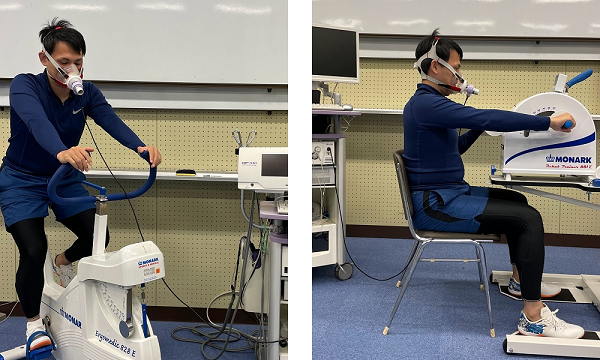Research News
Feb 8, 2024
- Human Life and Ecology
Beyond the pedals: testing upper limb feasibility of cardiopulmonary exercise testing
Evaluating cardiopulmonary function using upper limb exercise testing as an alternative for patients with lower limb injuries or disabilities
(Left) Cycle ergometer and (right) arm crank ergometer
The ergometers were used to investigate the relationship between heart rate and oxygen uptake during exercise testing using lower and upper limbs while also estimating maximal oxygen uptake
Credit: Osaka Metropolitan University

How can doctors or researchers conduct cardiopulmonary exercise testing in individuals with lower limb injuries or disabilities that make it impossible to pedal a stationary exercise bicycle for the test? Conventional cardiopulmonary exercise tests measure how much air we breathe in and how much oxygen is required during exercise. The tests also determine the maximal oxygen uptake – a cardiopulmonary function metric that indicates the maximum amount of oxygen your body can take in one minute. If the lower limbs cannot be exercised, it necessitates an upper limb alternative. However, no clear protocol for an upper limb exercise test has been fully established.
A team of researchers from Osaka Metropolitan University led by Professor Hisayo Yokoyama of the Research Center for Urban Health and Sports, Specially Appointed Assistant Professor Miwako Deguchi and Specially Appointed Professor Nobuko Hongu of the Graduate School of Human Life and Ecology investigated whether cardiopulmonary exercise testing with the upper limbs can be considered as reliable as those conducted with the lower limbs. The study assessed the relationship between heart rate and oxygen uptake while estimating the maximal oxygen uptake during exercise testing using cycle and arm crank ergometers in 17 male collegiate athletes from rowing and cycling clubs, with excellent upper and lower limb function, respectively.
The results showed that the estimated maximal oxygen uptake was lower on the arm crank ergometer for both the rowing and cycling teams than on the cycle ergometer. “Exercise testing using arm crank ergometers underestimate cardiopulmonary function, regardless of upper limb training status, and cannot substitute that of cycle ergometers, at least for the assessment of cardiopulmonary function,” said Dr. Deguchi. “In order to conduct exercise testing with arm crank ergometers in the future to assess cardiopulmonary function, it is necessary to clarify what factors affect the relationship between heart rate and oxygen uptake during exercise. We intend to use the results obtained in this study as a springboard for further research to expand the applicability of exercise testing using the upper limbs.”
Their findings were published in Applied Sciences.
Funding
This research was funded in part by FY2022 Collaborative Research Grant for Cooperative Research from Osaka Metropolitan University (No. 2022-4).
Paper Information
Journal: Applied Sciences
Title: Does Exercise Testing with Arm Crank Ergometer Substitute for Cycle Ergometer to Evaluate Exercise Capacity?
DOI: 10.3390/app132312926
Author: Miwako Deguchi, Hisayo Yokoyama, Nobuko Hongu, Atsuya Toya, Takahiro Matsutake, Yuta Suzuki, Daiki Imai, Yuko Yamazaki, Masanori Emoto and Kazunobu Okazaki
Published: 3 December 2023
URL: https://doi.org/10.3390/app132312926
Contact
Research Center for Urban Health and Sports
Prof. Hisayo Yokoyama
E-mail: yokoyama_hisayo[at]omu.ac.jp
*Please change [at] to @.
SDGs
